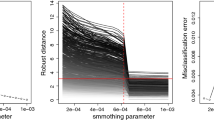Abstract
Many machine-learning approaches rely on maximizing the log-likelihood for parameter estimation. While for large sets of data this usually yields reasonable results, for smaller ones, this approach raises challenges related to the existence or number of optima, as well as to the appropriateness of the chosen model. In this paper, an Extremal optimization approach is proposed as an alternative to expectation maximization for the Gaussian Mixture Model, in an attempt to find parameters that better model the data than those provided by the direct maximization of the log-likelihood function. The behavior of the approach is illustrated by using numerical experiments on a set of synthetic and real-world data.
Access this chapter
Tax calculation will be finalised at checkout
Purchases are for personal use only
Similar content being viewed by others
References
Addagarla, S., Amalanathan, A.: Probabilistic unsupervised machine learning approach for a similar image recommender system for E-commerce. Symmetry 12(11), 1–17 (2020)
Ansari, S., Du, H., Naghdy, F., Stirling, D.: Automatic driver cognitive fatigue detection based on upper body posture variations. Expert Syst. Appl. 203 (2022). https://doi.org/10.1016/j.eswa.2022.117568
Bala Suresh, P., Nalinadevi, K.: Abnormal behaviour detection in smart home environments. In: Lecture Notes on Data Engineering and Communications Technologies, vol. 96, p. 300 (2022). https://doi.org/10.1007/978-981-16-7167-8_22
Bang, J., Kim, C., Wu, K., Sim, A., Byna, S., Kim, S., Eom, H.: HPC workload characterization using feature selection and clustering, pp. 33–40 (2020). https://doi.org/10.1145/3391812.3396270
Boettcher, S., Percus, A.G.: Optimization with extremal dynamics. Phys. Rev. Lett. 86, 5211–5214 (2001)
Davagdorj, K., Wang, L., Li, M., Pham, V.H., Ryu, K., Theera-Umpon, N.: Discovering thematically coherent biomedical documents using contextualized bidirectional encoder representations from transformers-based clustering. Int. J. Environ. Res. Publ. Health 19(10) (2022). https://doi.org/10.3390/ijerph19105893
De Salvio, D., D’Orazio, D., Garai, M.: Unsupervised analysis of background noise sources in active offices. J. Acoust. Soc. Am. 149(6), 4049–4060 (2021)
Dousty, M., Zariffa, J.: Towards clustering hand grasps of individuals with spinal cord injury in egocentric video, pp. 2151–2154 (2020). https://doi.org/10.1109/EMBC44109.2020.9175918
Dua, D., Graff, C.: UCI machine learning repository (2017). https://www.archive.ics.uci.edu/ml
Greenwood, D., Taverner, T., Adderley, N., Price, M., Gokhale, K., Sainsbury, C., Gallier, S., Welch, C., Sapey, E., Murray, D., Fanning, H., Ball, S., Nirantharakumar, K., Croft, W., Moss, P.: Machine learning of COVID-19 clinical data identifies population structures with therapeutic potential. iScience 25(7) (2022). https://doi.org/10.1016/j.isci.2022.104480
Guo, J., Chen, H., Shen, Z., Wang, Z.: Image denoising based on global image similar patches searching and HOSVD to patches tensor. EURASIP J. Adv. Signal Process. 2022(1) (2022). https://doi.org/10.1186/s13634-021-00798-4
He, M., Guo, W.: An integrated approach for bearing health indicator and stage division using improved gaussian mixture model and confidence value. IEEE Trans. Ind. Inform. 18(8), 5219–5230 (2022). https://doi.org/10.1109/TII.2021.3123060
Kamsing, P., Torteeka, P., Yooyen, S., Yenpiem, S., Delahaye, D., Notry, P., Phisannupawong, T., Channumsin, S.: Aircraft trajectory recognition via statistical analysis clustering for Suvarnabhumi International Airport, pp. 290–297 (2020). https://doi.org/10.23919/ICACT48636.2020.9061368
Kwon, S., Seo, I., Noh, H., Kim, B.: Hyperspectral retrievals of suspended sediment using cluster-based machine learning regression in shallow waters. Sci. Total Environ. 833 (2022). https://doi.org/10.1016/j.scitotenv.2022.155168
Liu, Y., Li, Z., Xiong, H., Gao, X., Wu, J.: Understanding of internal clustering validation measures. In: 2010 IEEE International Conference on Data Mining, pp. 911–916 (2010). https://doi.org/10.1109/ICDM.2010.35
Lu, Y., Chen, Y., Chen, M., Chen, P., Zeng, G.: Extremal Optimization: fundamentals, Algorithms, and Applications. CRC Press (2018). https://www.books.google.ro/books?id=3jH3DwAAQBAJ
Malinowski, M., Povinelli, R.: Using smart meters to learn water customer behavior. IEEE Trans. Eng. Manag. 69(3), 729–741 (2022). https://doi.org/10.1109/TEM.2020.2995529
Pedregosa, F., Varoquaux, G., Gramfort, A., Michel, V., Thirion, B., Grisel, O., Blondel, M., Prettenhofer, P., Weiss, R., Dubourg, V., Vanderplas, J., Passos, A., Cournapeau, D., Brucher, M., Perrot, M., Duchesnay, E.: Scikit-learn: machine learning in python. J. Mach. Learn. Res. 12, 2825–2830 (2011)
Poggio, T., Smale, S.: The mathematics of learning: dealing with data. Not. Am. Math. Soc. 50, 2003 (2003)
Rousseeuw, P.J.: Silhouettes: A graphical aid to the interpretation and validation of cluster analysis. J. Computat. Appl. Math. 20, 53–65 (1987). https://doi.org/10.1016/0377-0427(87)90125-7. https://www.sciencedirect.com/science/article/pii/0377042787901257
Saranya, S., Poonguzhali, S., Karunakaran, S.: Gaussian mixture model based clustering of Manual muscle testing grades using surface Electromyogram signals. Physical and Engineering Sciences in Medicine 43(3), 837–847 (2020). https://doi.org/10.1007/s13246-020-00880-5
Vakeel, A., Vantari, N., Reddy, S., Muthyapu, R., Chavan, A.: Machine learning models for predicting and clustering customer churn based on boosting algorithms and gaussian mixture model (2022). https://doi.org/10.1109/ICONAT53423.2022.9725957
Wisesty, U., Mengko, T.: Comparison of dimensionality reduction and clustering methods for SARS-CoV-2 genome. Bull. Electr. Eng. Inform. 10(4), 2170–2180 (2021). https://doi.org/10.11591/EEI.V10I4.2803
Zaki, M.J., Meira Jr., W.: Data Mining and Machine Learning: fundamental Concepts and Algorithms, 2 edn. Cambridge University Press (2020). https://doi.org/10.1017/9781108564175
Zhang, B., Yan, X., Liu, G., Fan, K.: Multi-source fault diagnosis of chiller plant sensors based on an improved ensemble empirical mode decomposition gaussian mixture model. Energy Rep. 8, 2831–2842 (2022). https://doi.org/10.1016/j.egyr.2022.01.179
Zhang, J., Lu, H., Sun, J.: Improved driver clustering framework by considering the variability of driving behaviors across traffic operation conditions. J. Transp. Eng. Part A: Syst. 148(7) (2022). https://doi.org/10.1061/JTEPBS.0000686
Zhao, X.W., Ji, J.Z., Yao, Y.: Insula functional parcellation by searching Gaussian mixture model (GMM) using immune clonal selection (ICS) algorithm. Zhejiang Daxue Xuebao (Gongxue Ban)/J. Zhejiang Univ. (Eng Sci) 51(12), 2320–2331 (2017). https://doi.org/10.3785/j.issn.1008-973X.2017.12.003
This work was supported by a grant of the Romanian Ministry of Education and Research, CNCS—UEFISCDI, project number PN-III-P4-ID-PCE-2020-2360, within PNCDI III.
Author information
Authors and Affiliations
Corresponding author
Editor information
Editors and Affiliations
Rights and permissions
Copyright information
© 2023 The Author(s), under exclusive license to Springer Nature Switzerland AG
About this paper
Cite this paper
Lung, R.I. (2023). A Gaussian Mixture Clustering Approach Based on Extremal Optimization. In: Abraham, A., Hong, TP., Kotecha, K., Ma, K., Manghirmalani Mishra, P., Gandhi, N. (eds) Hybrid Intelligent Systems. HIS 2022. Lecture Notes in Networks and Systems, vol 647. Springer, Cham. https://doi.org/10.1007/978-3-031-27409-1_71
Download citation
DOI: https://doi.org/10.1007/978-3-031-27409-1_71
Published:
Publisher Name: Springer, Cham
Print ISBN: 978-3-031-27408-4
Online ISBN: 978-3-031-27409-1
eBook Packages: Intelligent Technologies and RoboticsIntelligent Technologies and Robotics (R0)




